An Analysis of Coca-Cola's Branding Strategies and Consumer Behavior
VerifiedAdded on 2023/01/07
|18
|1626
|23
Report
AI Summary
This report provides an in-depth analysis of Coca-Cola's branding strategies and their influence on consumer behavior. It begins with an introduction to the Coca-Cola Company, followed by an examination of consumer identification and target markets. The report delves into various marketing and branding strategies employed by Coca-Cola, including focusing on individuals, uniqueness, content, visuals, and vision statements. It then explores consumer behavior through psychological concepts such as the trio of needs and Murray's psychogenic needs, as well as external socio-cultural concepts like family decision-making and high vs. low context cultures. The analysis further discusses the impact of these strategies on consumer decision-making, highlighting tactics like targeting millennials and iconic product design. The report concludes with recommendations for Coca-Cola, such as introducing innovative products and leveraging promotional techniques. The references include academic sources related to branding and consumer behavior, providing a comprehensive overview of the topic.
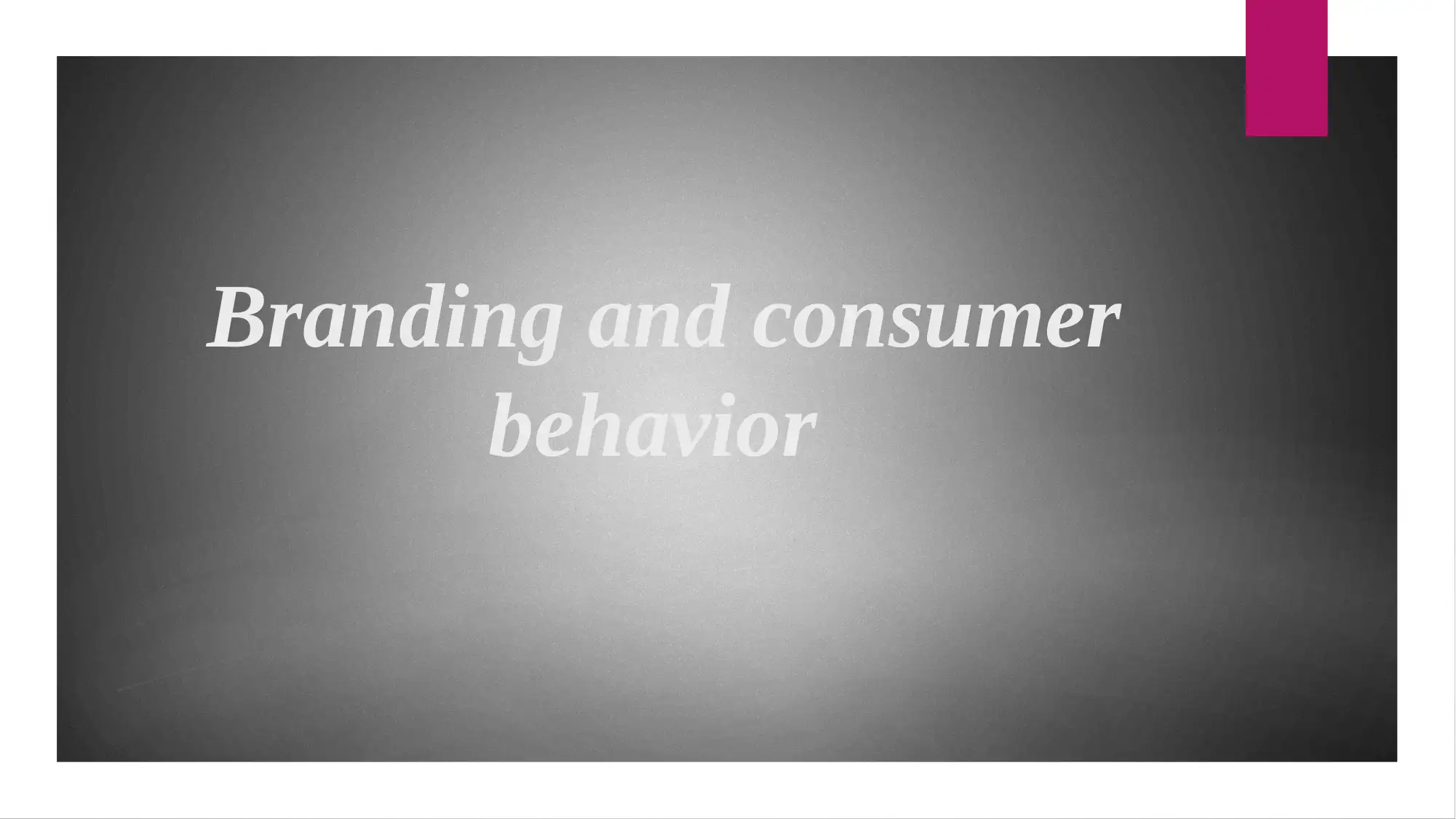
Branding and consumer
behavior
behavior
Paraphrase This Document
Need a fresh take? Get an instant paraphrase of this document with our AI Paraphraser
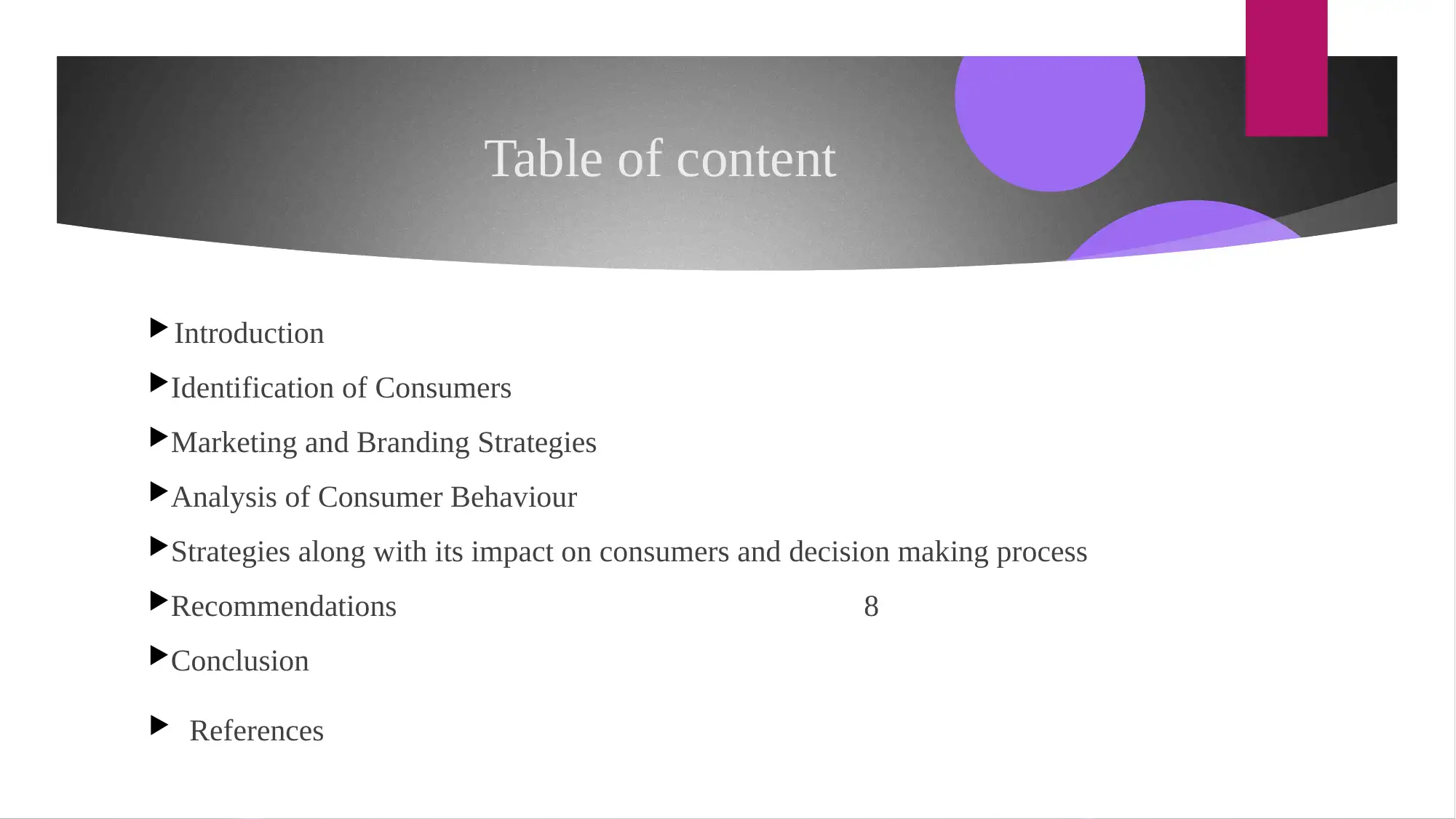
Table of content
Introduction
Identification of Consumers
Marketing and Branding Strategies
Analysis of Consumer Behaviour
Strategies along with its impact on consumers and decision making process
Recommendations 8
Conclusion
References
Introduction
Identification of Consumers
Marketing and Branding Strategies
Analysis of Consumer Behaviour
Strategies along with its impact on consumers and decision making process
Recommendations 8
Conclusion
References
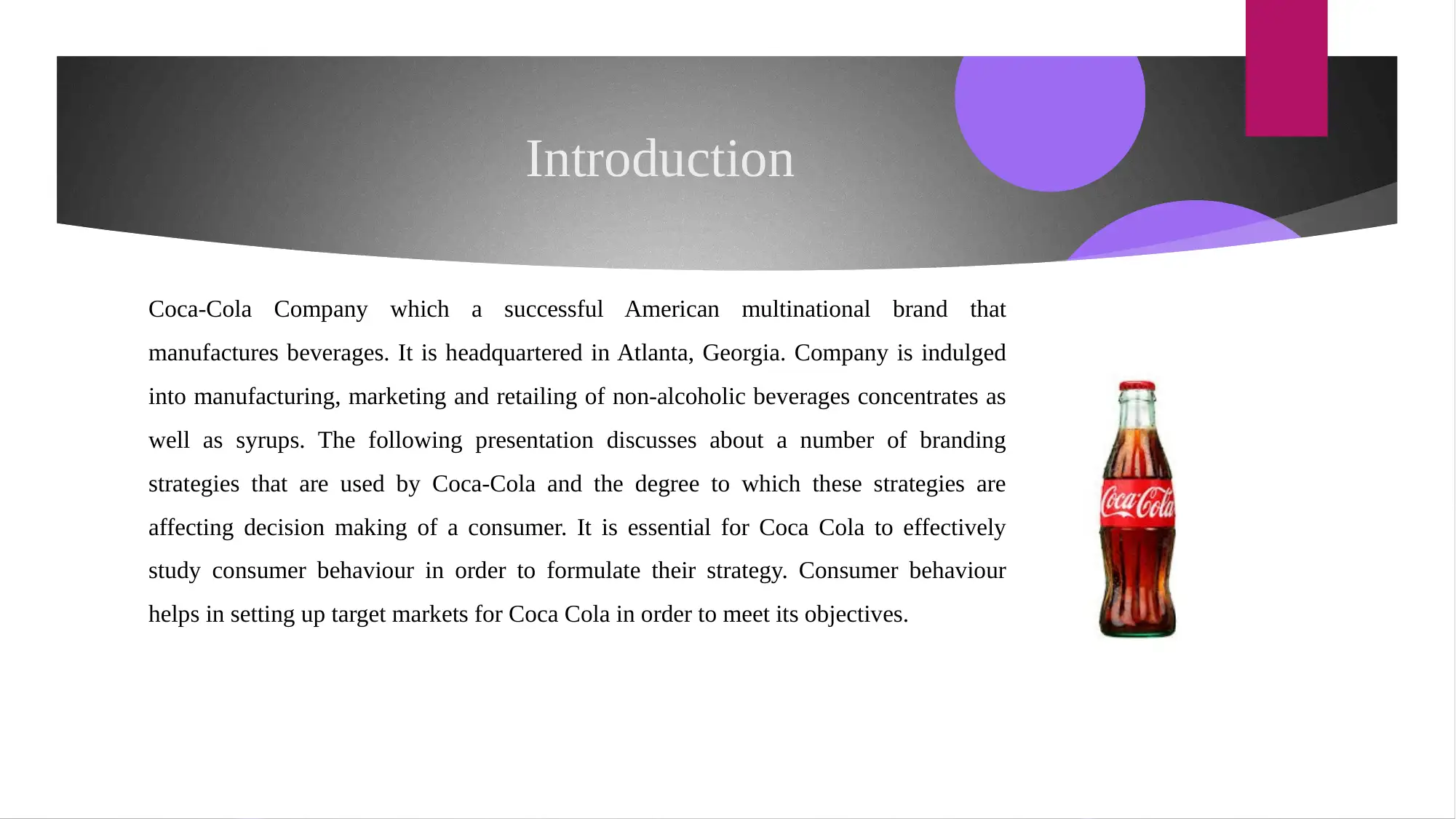
Introduction
Coca-Cola Company which a successful American multinational brand that
manufactures beverages. It is headquartered in Atlanta, Georgia. Company is indulged
into manufacturing, marketing and retailing of non-alcoholic beverages concentrates as
well as syrups. The following presentation discusses about a number of branding
strategies that are used by Coca-Cola and the degree to which these strategies are
affecting decision making of a consumer. It is essential for Coca Cola to effectively
study consumer behaviour in order to formulate their strategy. Consumer behaviour
helps in setting up target markets for Coca Cola in order to meet its objectives.
Coca-Cola Company which a successful American multinational brand that
manufactures beverages. It is headquartered in Atlanta, Georgia. Company is indulged
into manufacturing, marketing and retailing of non-alcoholic beverages concentrates as
well as syrups. The following presentation discusses about a number of branding
strategies that are used by Coca-Cola and the degree to which these strategies are
affecting decision making of a consumer. It is essential for Coca Cola to effectively
study consumer behaviour in order to formulate their strategy. Consumer behaviour
helps in setting up target markets for Coca Cola in order to meet its objectives.
⊘ This is a preview!⊘
Do you want full access?
Subscribe today to unlock all pages.

Trusted by 1+ million students worldwide
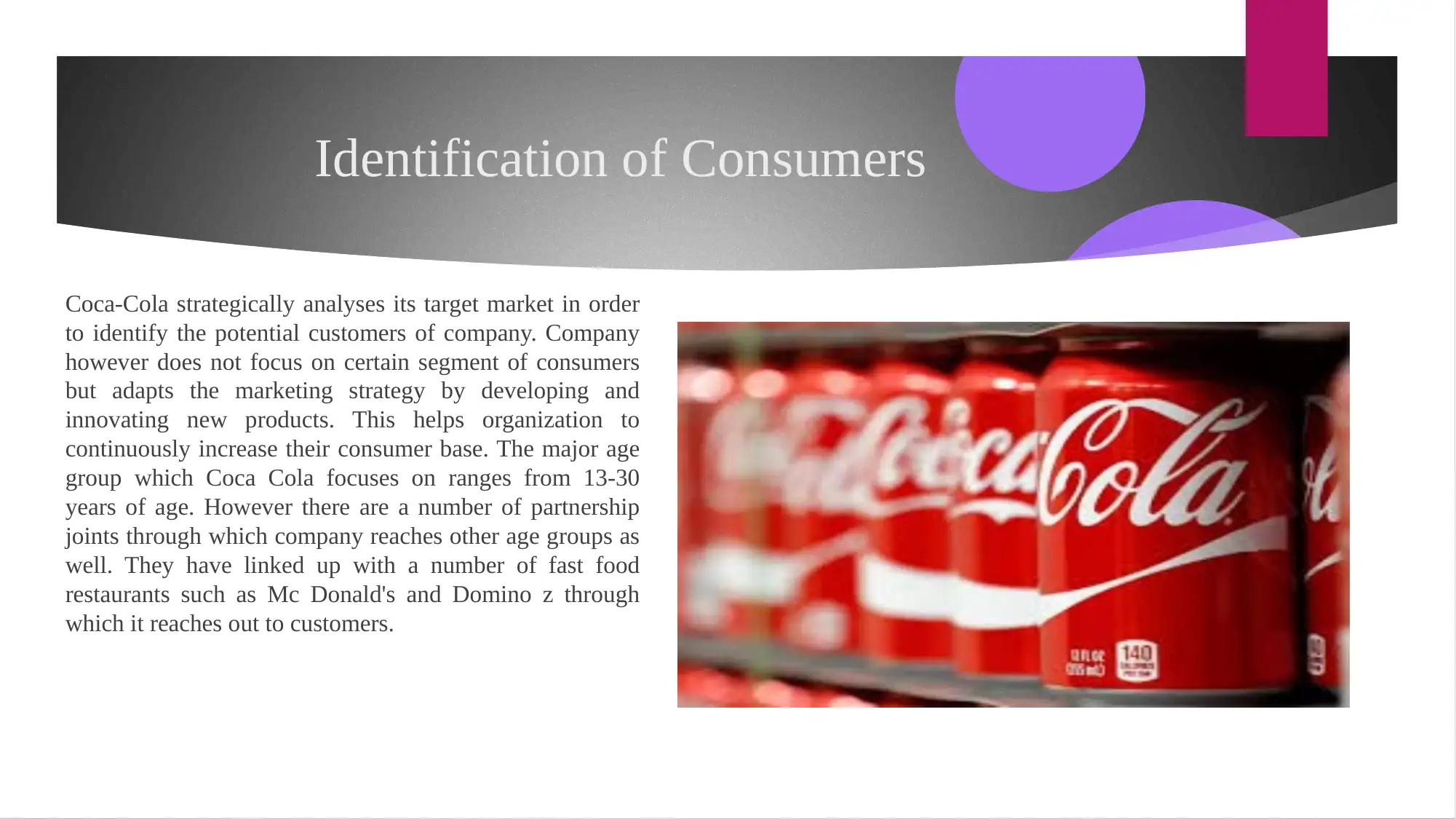
Identification of Consumers
Coca-Cola strategically analyses its target market in order
to identify the potential customers of company. Company
however does not focus on certain segment of consumers
but adapts the marketing strategy by developing and
innovating new products. This helps organization to
continuously increase their consumer base. The major age
group which Coca Cola focuses on ranges from 13-30
years of age. However there are a number of partnership
joints through which company reaches other age groups as
well. They have linked up with a number of fast food
restaurants such as Mc Donald's and Domino z through
which it reaches out to customers.
Coca-Cola strategically analyses its target market in order
to identify the potential customers of company. Company
however does not focus on certain segment of consumers
but adapts the marketing strategy by developing and
innovating new products. This helps organization to
continuously increase their consumer base. The major age
group which Coca Cola focuses on ranges from 13-30
years of age. However there are a number of partnership
joints through which company reaches other age groups as
well. They have linked up with a number of fast food
restaurants such as Mc Donald's and Domino z through
which it reaches out to customers.
Paraphrase This Document
Need a fresh take? Get an instant paraphrase of this document with our AI Paraphraser
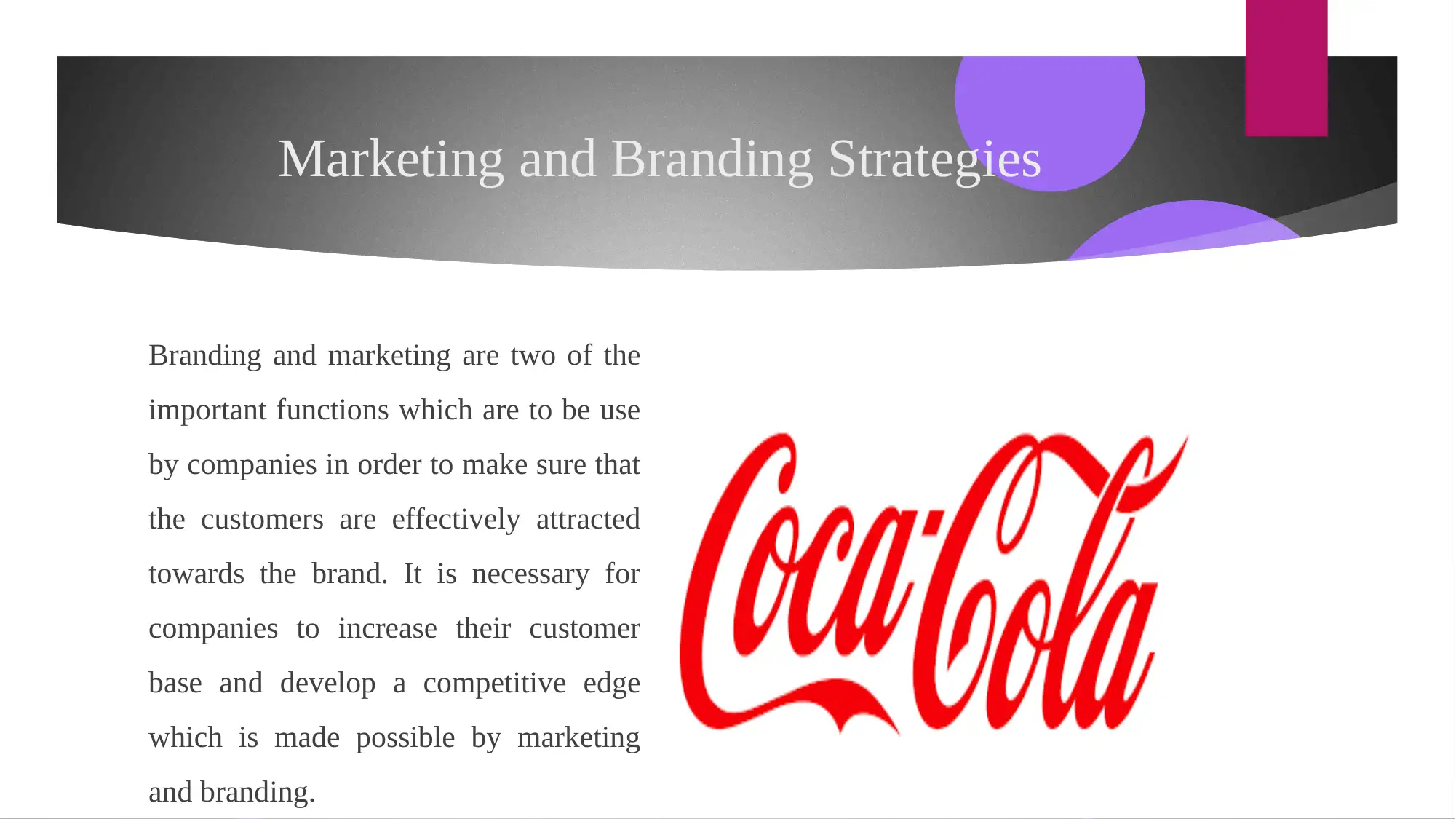
Marketing and Branding Strategies
Branding and marketing are two of the
important functions which are to be use
by companies in order to make sure that
the customers are effectively attracted
towards the brand. It is necessary for
companies to increase their customer
base and develop a competitive edge
which is made possible by marketing
and branding.
Branding and marketing are two of the
important functions which are to be use
by companies in order to make sure that
the customers are effectively attracted
towards the brand. It is necessary for
companies to increase their customer
base and develop a competitive edge
which is made possible by marketing
and branding.
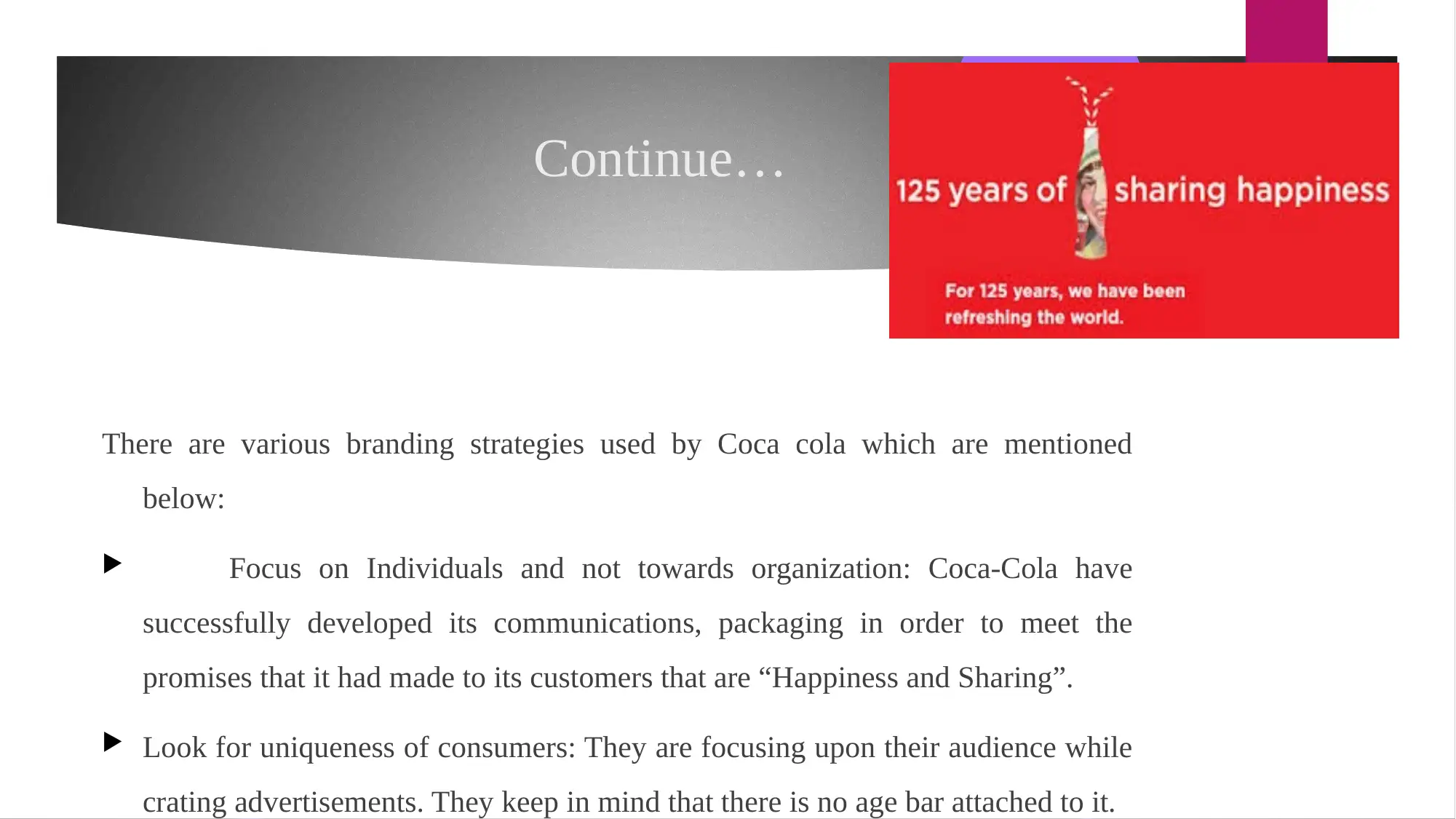
Continue…
There are various branding strategies used by Coca cola which are mentioned
below:
Focus on Individuals and not towards organization: Coca-Cola have
successfully developed its communications, packaging in order to meet the
promises that it had made to its customers that are “Happiness and Sharing”.
Look for uniqueness of consumers: They are focusing upon their audience while
crating advertisements. They keep in mind that there is no age bar attached to it.
There are various branding strategies used by Coca cola which are mentioned
below:
Focus on Individuals and not towards organization: Coca-Cola have
successfully developed its communications, packaging in order to meet the
promises that it had made to its customers that are “Happiness and Sharing”.
Look for uniqueness of consumers: They are focusing upon their audience while
crating advertisements. They keep in mind that there is no age bar attached to it.
⊘ This is a preview!⊘
Do you want full access?
Subscribe today to unlock all pages.

Trusted by 1+ million students worldwide
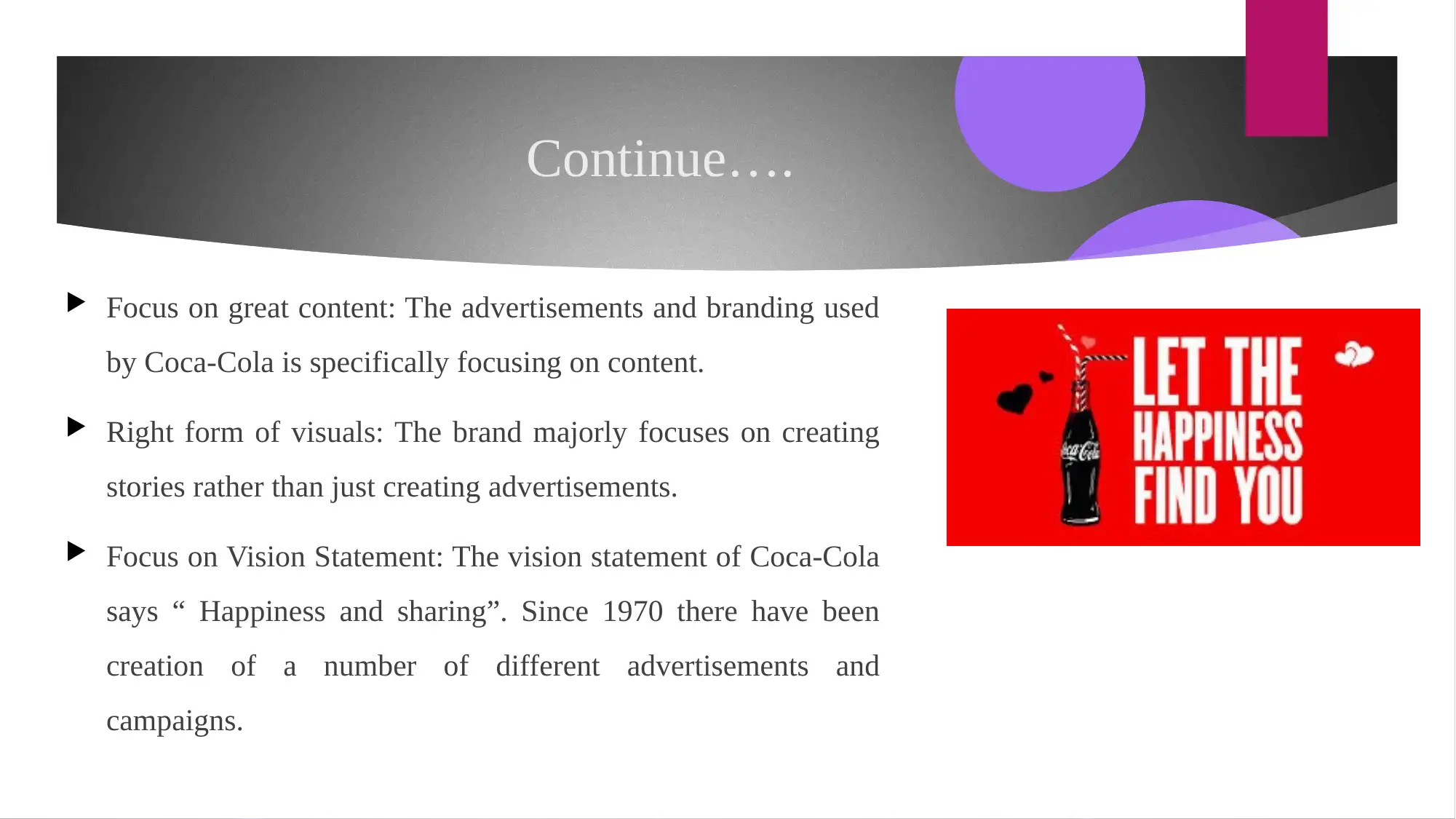
Continue….
Focus on great content: The advertisements and branding used
by Coca-Cola is specifically focusing on content.
Right form of visuals: The brand majorly focuses on creating
stories rather than just creating advertisements.
Focus on Vision Statement: The vision statement of Coca-Cola
says “ Happiness and sharing”. Since 1970 there have been
creation of a number of different advertisements and
campaigns.
Focus on great content: The advertisements and branding used
by Coca-Cola is specifically focusing on content.
Right form of visuals: The brand majorly focuses on creating
stories rather than just creating advertisements.
Focus on Vision Statement: The vision statement of Coca-Cola
says “ Happiness and sharing”. Since 1970 there have been
creation of a number of different advertisements and
campaigns.
Paraphrase This Document
Need a fresh take? Get an instant paraphrase of this document with our AI Paraphraser
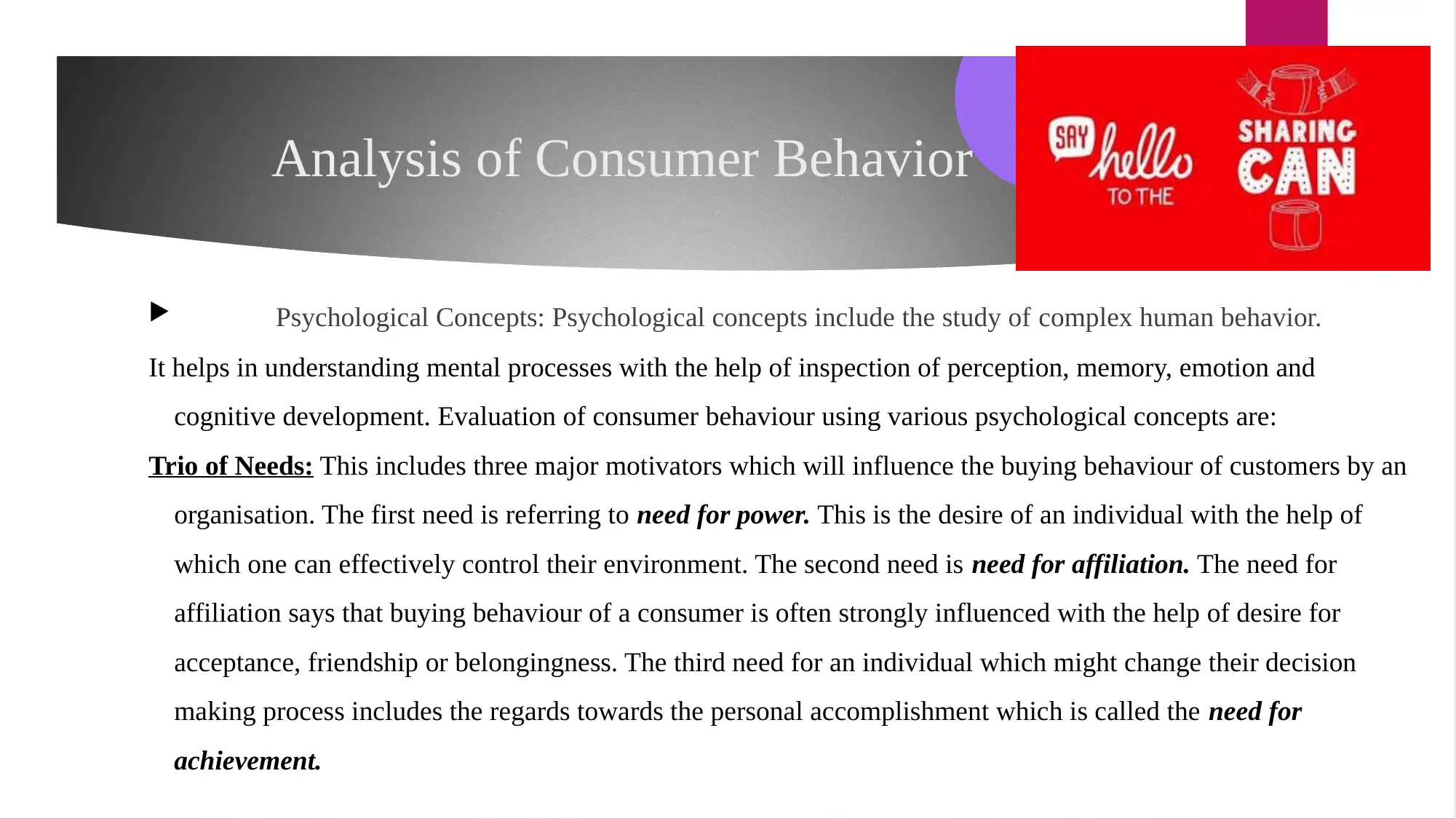
Analysis of Consumer Behavior
Psychological Concepts: Psychological concepts include the study of complex human behavior.
It helps in understanding mental processes with the help of inspection of perception, memory, emotion and
cognitive development. Evaluation of consumer behaviour using various psychological concepts are:
Trio of Needs: This includes three major motivators which will influence the buying behaviour of customers by an
organisation. The first need is referring to need for power. This is the desire of an individual with the help of
which one can effectively control their environment. The second need is need for affiliation. The need for
affiliation says that buying behaviour of a consumer is often strongly influenced with the help of desire for
acceptance, friendship or belongingness. The third need for an individual which might change their decision
making process includes the regards towards the personal accomplishment which is called the need for
achievement.
Psychological Concepts: Psychological concepts include the study of complex human behavior.
It helps in understanding mental processes with the help of inspection of perception, memory, emotion and
cognitive development. Evaluation of consumer behaviour using various psychological concepts are:
Trio of Needs: This includes three major motivators which will influence the buying behaviour of customers by an
organisation. The first need is referring to need for power. This is the desire of an individual with the help of
which one can effectively control their environment. The second need is need for affiliation. The need for
affiliation says that buying behaviour of a consumer is often strongly influenced with the help of desire for
acceptance, friendship or belongingness. The third need for an individual which might change their decision
making process includes the regards towards the personal accomplishment which is called the need for
achievement.
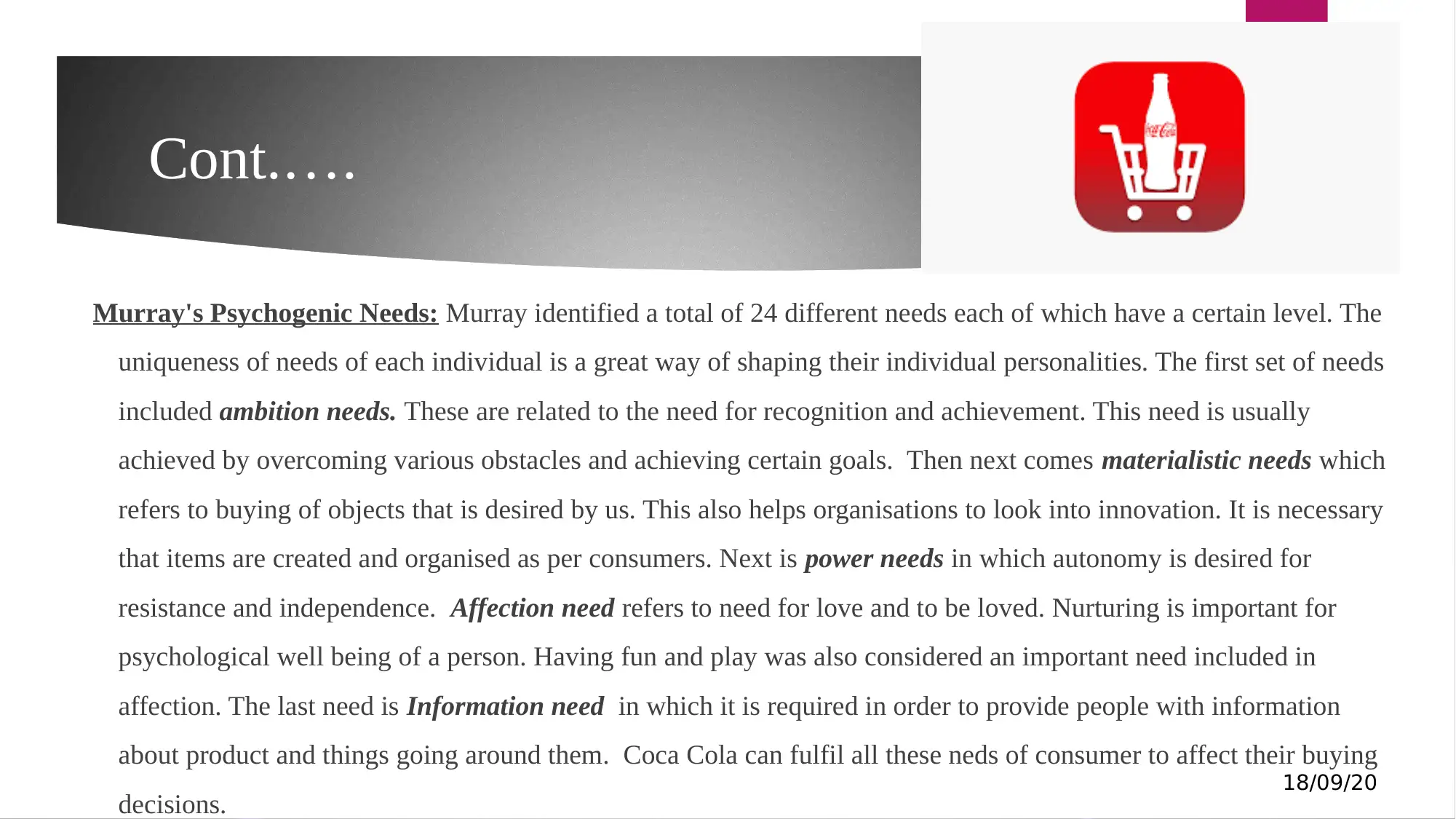
Cont.….
Murray's Psychogenic Needs: Murray identified a total of 24 different needs each of which have a certain level. The
uniqueness of needs of each individual is a great way of shaping their individual personalities. The first set of needs
included ambition needs. These are related to the need for recognition and achievement. This need is usually
achieved by overcoming various obstacles and achieving certain goals. Then next comes materialistic needs which
refers to buying of objects that is desired by us. This also helps organisations to look into innovation. It is necessary
that items are created and organised as per consumers. Next is power needs in which autonomy is desired for
resistance and independence. Affection need refers to need for love and to be loved. Nurturing is important for
psychological well being of a person. Having fun and play was also considered an important need included in
affection. The last need is Information need in which it is required in order to provide people with information
about product and things going around them. Coca Cola can fulfil all these neds of consumer to affect their buying
decisions. 18/09/20
Murray's Psychogenic Needs: Murray identified a total of 24 different needs each of which have a certain level. The
uniqueness of needs of each individual is a great way of shaping their individual personalities. The first set of needs
included ambition needs. These are related to the need for recognition and achievement. This need is usually
achieved by overcoming various obstacles and achieving certain goals. Then next comes materialistic needs which
refers to buying of objects that is desired by us. This also helps organisations to look into innovation. It is necessary
that items are created and organised as per consumers. Next is power needs in which autonomy is desired for
resistance and independence. Affection need refers to need for love and to be loved. Nurturing is important for
psychological well being of a person. Having fun and play was also considered an important need included in
affection. The last need is Information need in which it is required in order to provide people with information
about product and things going around them. Coca Cola can fulfil all these neds of consumer to affect their buying
decisions. 18/09/20
⊘ This is a preview!⊘
Do you want full access?
Subscribe today to unlock all pages.

Trusted by 1+ million students worldwide
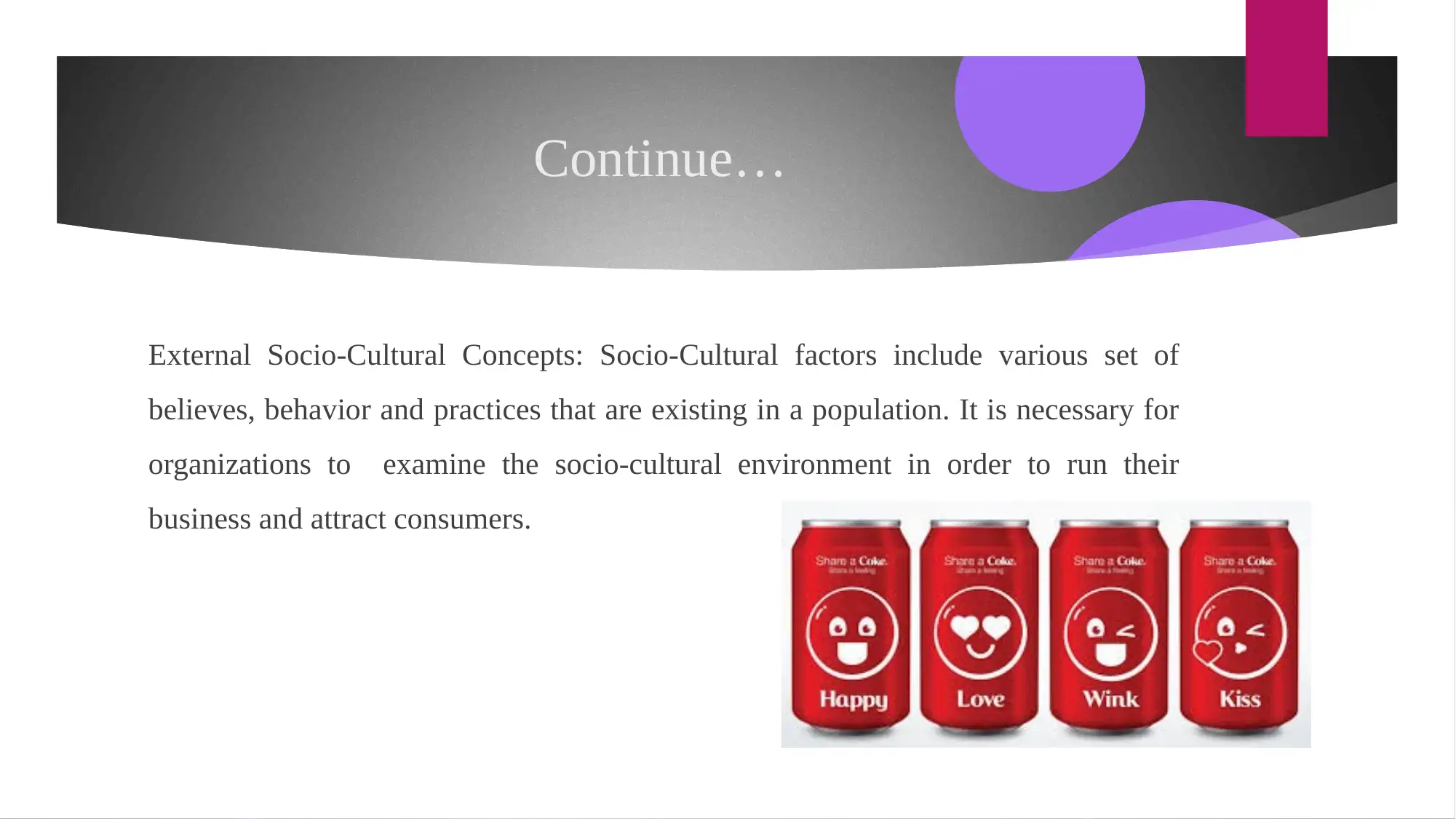
Continue…
External Socio-Cultural Concepts: Socio-Cultural factors include various set of
believes, behavior and practices that are existing in a population. It is necessary for
organizations to examine the socio-cultural environment in order to run their
business and attract consumers.
External Socio-Cultural Concepts: Socio-Cultural factors include various set of
believes, behavior and practices that are existing in a population. It is necessary for
organizations to examine the socio-cultural environment in order to run their
business and attract consumers.
Paraphrase This Document
Need a fresh take? Get an instant paraphrase of this document with our AI Paraphraser
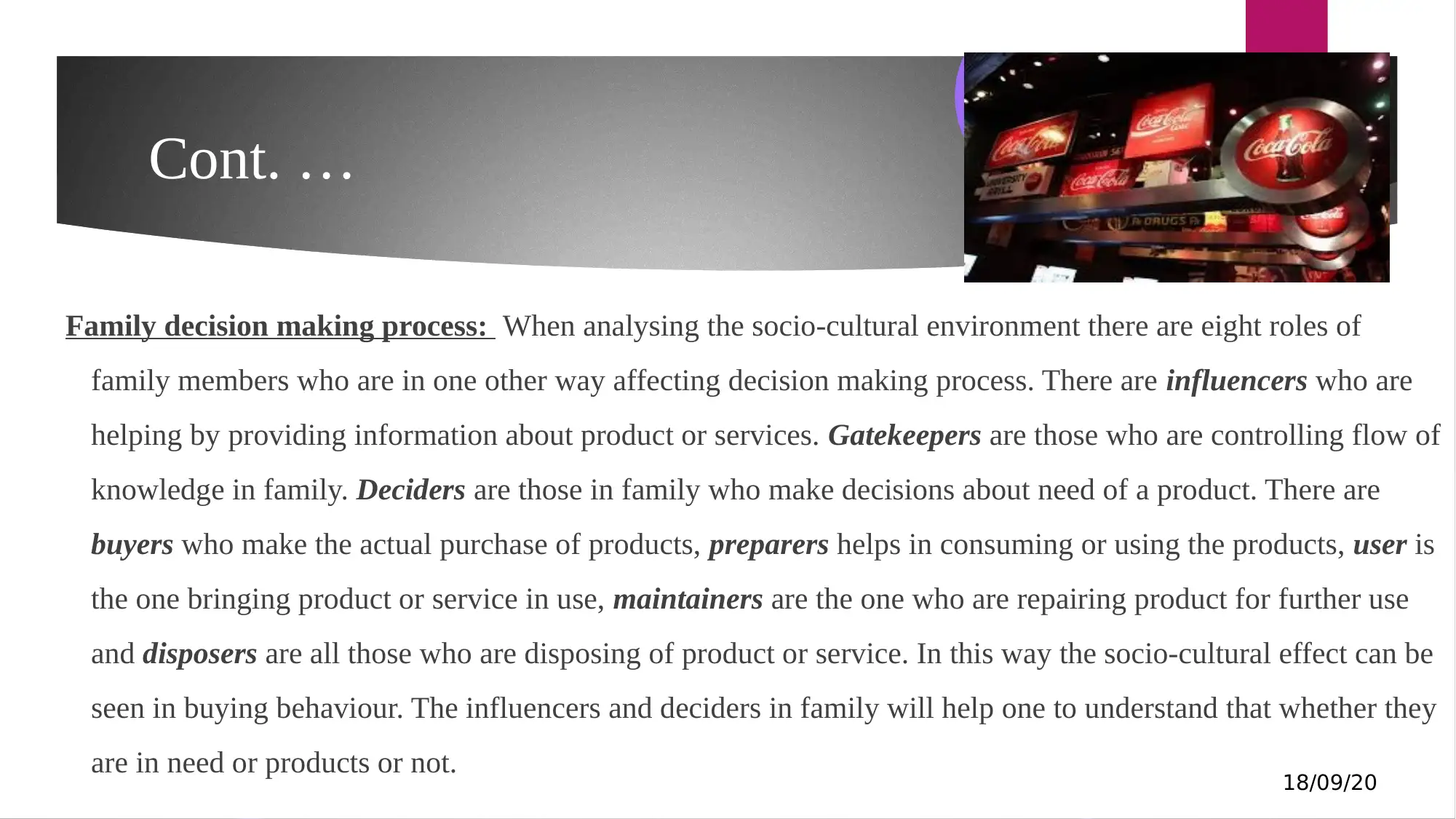
Cont. …
Family decision making process: When analysing the socio-cultural environment there are eight roles of
family members who are in one other way affecting decision making process. There are influencers who are
helping by providing information about product or services. Gatekeepers are those who are controlling flow of
knowledge in family. Deciders are those in family who make decisions about need of a product. There are
buyers who make the actual purchase of products, preparers helps in consuming or using the products, user is
the one bringing product or service in use, maintainers are the one who are repairing product for further use
and disposers are all those who are disposing of product or service. In this way the socio-cultural effect can be
seen in buying behaviour. The influencers and deciders in family will help one to understand that whether they
are in need or products or not. 18/09/20
Family decision making process: When analysing the socio-cultural environment there are eight roles of
family members who are in one other way affecting decision making process. There are influencers who are
helping by providing information about product or services. Gatekeepers are those who are controlling flow of
knowledge in family. Deciders are those in family who make decisions about need of a product. There are
buyers who make the actual purchase of products, preparers helps in consuming or using the products, user is
the one bringing product or service in use, maintainers are the one who are repairing product for further use
and disposers are all those who are disposing of product or service. In this way the socio-cultural effect can be
seen in buying behaviour. The influencers and deciders in family will help one to understand that whether they
are in need or products or not. 18/09/20
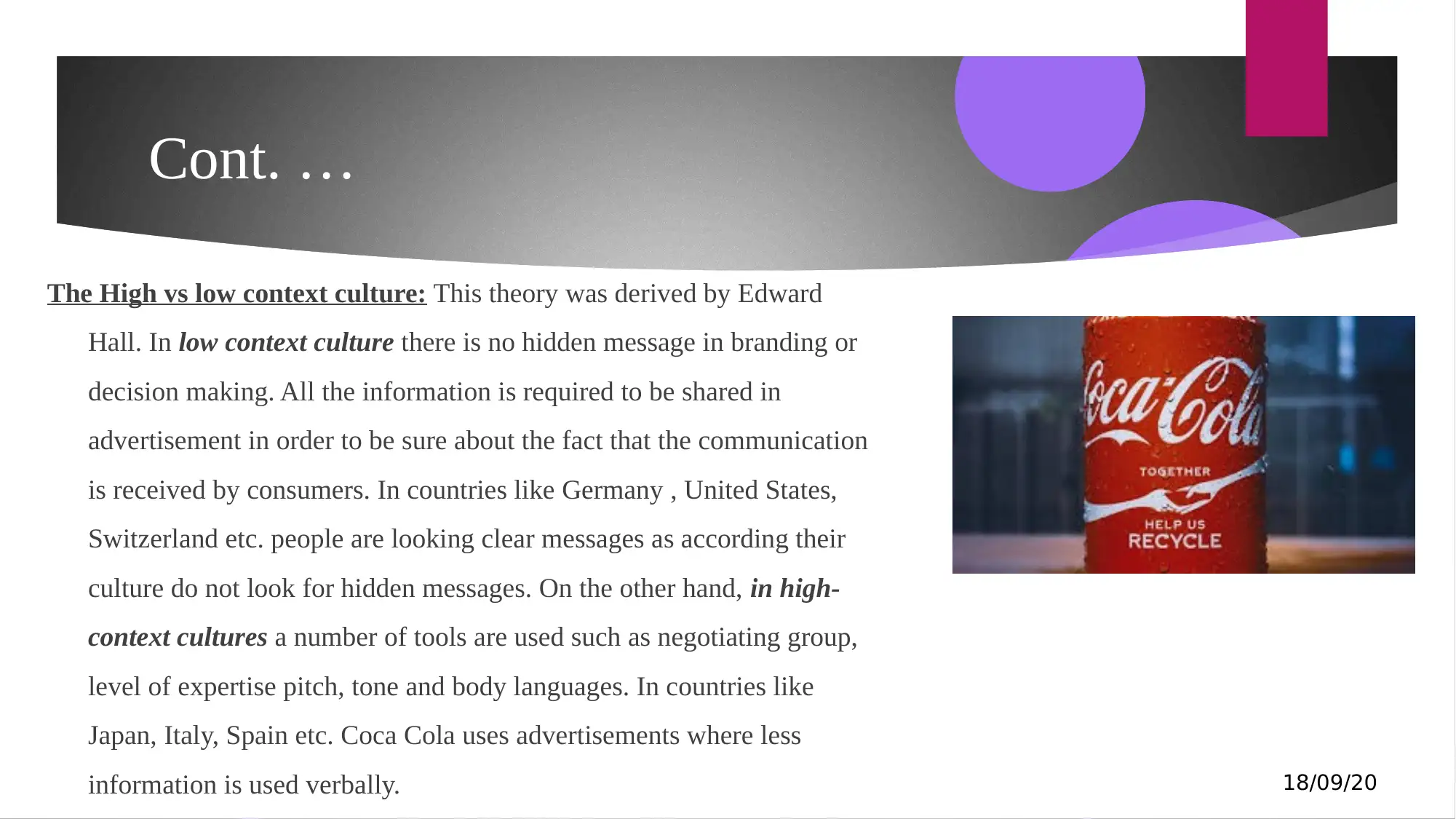
Cont. …
The High vs low context culture: This theory was derived by Edward
Hall. In low context culture there is no hidden message in branding or
decision making. All the information is required to be shared in
advertisement in order to be sure about the fact that the communication
is received by consumers. In countries like Germany , United States,
Switzerland etc. people are looking clear messages as according their
culture do not look for hidden messages. On the other hand, in high-
context cultures a number of tools are used such as negotiating group,
level of expertise pitch, tone and body languages. In countries like
Japan, Italy, Spain etc. Coca Cola uses advertisements where less
information is used verbally. 18/09/20
The High vs low context culture: This theory was derived by Edward
Hall. In low context culture there is no hidden message in branding or
decision making. All the information is required to be shared in
advertisement in order to be sure about the fact that the communication
is received by consumers. In countries like Germany , United States,
Switzerland etc. people are looking clear messages as according their
culture do not look for hidden messages. On the other hand, in high-
context cultures a number of tools are used such as negotiating group,
level of expertise pitch, tone and body languages. In countries like
Japan, Italy, Spain etc. Coca Cola uses advertisements where less
information is used verbally. 18/09/20
⊘ This is a preview!⊘
Do you want full access?
Subscribe today to unlock all pages.

Trusted by 1+ million students worldwide
1 out of 18
Related Documents
Your All-in-One AI-Powered Toolkit for Academic Success.
+13062052269
info@desklib.com
Available 24*7 on WhatsApp / Email
![[object Object]](/_next/static/media/star-bottom.7253800d.svg)
Unlock your academic potential
Copyright © 2020–2025 A2Z Services. All Rights Reserved. Developed and managed by ZUCOL.




